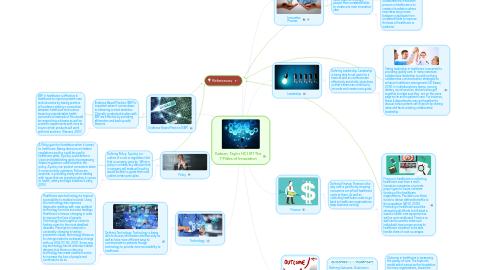
1. References
2. Policy
2.1. Defining Policy: A policy is a outline of a rule or regulation that that a company goes by. When a policy is a made, any decision that a company will make will a policy would be able to guide them and outline certain principles.
2.1.1. A Policy give the foundation when it comes to healthcare. Basing decisions on federal regulations a policy could be used in healthcare goals. A policy could define a vision and establishing goals encompassing federal regulations outlined within the policy. A policy can protect consumers when it comes to daily operation. Polices are essential in providing clarity when dealing with issues that are important when it comes to health, safety and legal liabilities (Leahy, 2015)
3. Evidence-Based Practice (EBP)
3.1. Evidence Based Practice (EBP) is important when it comes down to obtaining correct statistics. Clinically conducted studies with EBP are effective by providing affirmation and back up with theories.
3.1.1. EBP in healthcare is effective in healthcare to improve patient care and outcomes by basing practice off evidence making a connection between healthcare and science lessening unpredictable health outcomes an example of this would be researching a disease as well as scientific experiments with mice to insure certain products will work with trial and error (Stevens, 2013)
4. Technology
4.1. Defining Technology: Technology is being able to access information electronically as well as have more efficient ways to communicate to patients though technology to provide more accessibility to healthcare.
4.1.1. Healthcare uses technology to improve accessibility to medical records. Using this technology also improves diagnostic readings with new updated technology for more accurate readings. Healthcare is forever changing in order to improve the lives of people. Technology has brought us closer to finding cures for the most deadliest diseases. Prescription medicine is constantly changing in tertiary prevention clause, technology allows us to change medicine as diseases change with our DNA (TCHC, 2017). Some may say technology has its unknown hidden dangers, but theres no denying technology has made medicine evolve to increase the lives of people and continues to do so.
5. Innovation Process
5.1. Define Innovation Process: A process where new ideas are obtained, meshing innovative ideas together amongst people from unrelated fields to create one main innovative idea.
5.1.1. The AHRQ Health Care Innovations Exchange defines health care innovation as the implementation of new or altered products, services, processes, systems, policies, organizational structures, or business models. To collaborate the innovation process in healthcare is to create a foundation where new ideas are process between individuals from unrelated fields to improve the base of healthcare or medicine.
6. Leadership
6.1. Defining Leadership: Leadership is being able to set goals for a team as well as communicate effectively and clarify objectives, so that a team can continue to innovate and create more goals.
6.1.1. Taking leadership in healthcare is essential to providing quality care. In many instances collaborative leadership is used involving collaborative communication strategies to enhance healthcare management (Al-Sawai, 2013). In multidisciplinary teams nursing, dietary, social services, and activities get together to make sure they are on the same page as far as the patients care. For instance, these 4 departments may get together to discuss how a patient can improve by sharing ideas and facts creating collaborative leadership.
7. Finance
7.1. Defining Finance: Finance is the way care is paid for by ensuring consumers can afford healthcare costs to them. As well as collecting healthcare costs to go back to healthcare organizations keep business running.
7.1.1. Finance in healthcare is collecting healthcare cost from a multi insurance companies or private payor types to insure constant funding of the healthcare organizations. Providers use these funds to deliver defined benefits to the population (WHO, 2018). Financing in healthcare would be exhausting all efforts to bill what is owed in health care equipment as well as room and board. Finance as well can be used to make sure individuals have proper access to healthcare insurance to be able handle share of cost coverages.
8. Outcome
8.1. Defining Outcome: Outcome is quality measures in a healthcare. Measuring quality of care to improve patient experience as well as increasing primary and secondary prevention methods to improve the quality of life in individuals.
8.1.1. Outcome in healthcare is measuring the quality of care. The triple aim model which serves as the foundation for many organizations, shows the quality of care goals to improve the health in population and to reduce cost of care benefits (Triple Aim for Populations, 2018) Measuring outcome amongst consumers can potentially let organizations know the need of each patient to improve the care given as well as the outcome.
